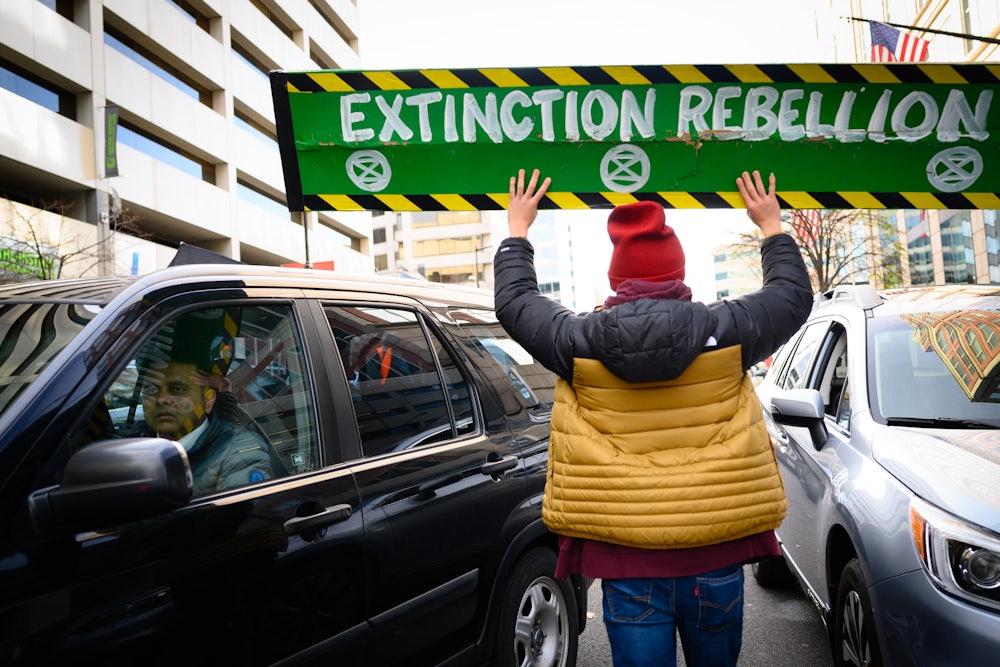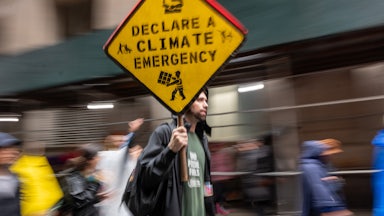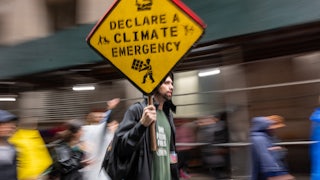The morning commute on Interstate 395 in Washington, D.C., was interrupted twice last month by the climate activist group Declare Emergency. As activists sat across highway lanes blocking traffic, drivers got out of their cars to confront the protesters. “We gotta go to fucking work!” one driver yelled. “We got kids to feed!” Another suggested the activists take their complaints to the White House. When police eventually cuffed and removed the protesters from the scene, the crowd cheered.
As the world gets warmer and warmer, climate activists have increasingly embraced disruptive tactics designed to communicate the urgent need for action. Their concern is widely shared: Two-thirds of Americans say they worry about global warming, and three-quarters of young people are “frightened of the future.” But we live in a country where most people depend on fossil-fueled infrastructure to get around—even if they are concerned about the emissions involved.
In videos of the highway blockade, climate activists and commuting workers appear, quite literally, to be on opposite sides: heroic environmentalists versus mindless consumers, or out-of-touch activists versus hardworking Americans, depending on your point of view. But in the fight for energy transition and a healthy planet, these groups are very much on the same side. The clash in Washington highlights a question the climate movement has only just begun to wrestle with: In the fight for swift and just climate action, what strategies can create urgency and disruption without blurring enemy lines?
We just lived through what might be the hottest summer on record, while government climate action remains achingly slow. From Extinction Rebellion to the U.K.-based Just Stop Oil, whose members tossed soup at a Van Gogh painting last year, there is a growing sense among some activist circles that slashing carbon emissions is too urgent to wait for the gears of “normal” politics to turn. Around 75,000 people turned out for New York’s March to End Fossil Fuels this past weekend, and 650 climate actions are planned across 54 countries to coincide with the U.N. General Assembly this week—people around the world are making a strong case that disruptive tactics are not only permissible but necessary.
For any tactic to be effective, it must fit into a clear strategy with well-defined goals. A good strategy is built on an understanding of which actors have the power to realize your goals, what it takes to influence or usurp those actors, where you have the leverage to pressure them, and what tactics make the best use of that leverage. The main downside to the Washington blockade was not the disruptiveness of the tactic but the vagueness of the strategy and goals. Carbon emissions must be slashed; oil must be kept in the ground; an emergency must be declared. But how does halting traffic on I-395 help us officially declare a climate emergency?
Let’s imagine an ideal outcome of Declare Emergency’s blockade: the press covers the protest and the subsequent arrests; those of us who see the coverage are persuaded that climate change must be immediately addressed. What then? Imagining a satisfying end to this story requires believing that if enough people are galvanized around climate change, emissions cuts will follow. While climate activists have for the most part moved beyond simply “raising awareness,” Declare Emergency’s blockade seems to be primarily an attempt to “wake people up” to the deadly seriousness of global warming. But as one blocked driver remarked, “You don’t think we know the earth is fucking melting?”
At this point, a wake-up call is not a serious strategy for decarbonization. The fact that the United States remains on track to blow past emissions targets set by the Paris Agreement is best explained by the economic and political power of Big Oil and related industries. They have been able to shape climate legislation to protect their interests and squash green projects that would strengthen working people’s independence from fossil fuels, like building out mass transit in the South. Climate measures championed by President Biden, like the Inflation Reduction Act, may reflect shifting attitudes about the seriousness of global warming. But the Faustian compromises required to pass that bill, including opening more of the Gulf to oil and gas drilling, suggest that U.S. climate policy is still beholden to corporate interests.
Denying climate change and vilifying climate activists remain powerful weapons in the fossil fuel industry’s arsenal, and the industry has worked in concert to wage international campaigns against protesters. But campaigns like these are not the ultimate source of the industry’s power. It takes not only knowledge but power to override corporate influence in government and win a rapid and just transition to a post-fossil economy. It can be difficult for local activists to match their small-scale efforts to the broader goal of shifting the balance of power.
One lesson from the I-395 clash that climate activists should keep in mind is that it is not ignorance but infrastructure that locks Americans into high-carbon lifestyles. The vast majority of Americans drive regularly and have little choice not to. This dependence on roads and highways—not to mention coal-powered electricity production, factory-farmed foods, and plastics—makes it nearly structurally impossible to rebel against this system. In a society where a delayed commute can mean losing your job (or sometimes worse), a blockade can feel like a hostage situation.
The second lesson follows from the first: The climate movement must prioritize bringing more and more working people into the fold. Disruption should be used in goal-oriented campaigns that respect workers’ constraints, raise their expectations, and advance their short- and long-term interests.
When members of the Union of Electrical, Radio, and Machine Workers of America, or UE, went on strike against train manufacturer Wabtec this past July, they did so to demand greater job security as well as commitments from the company to invest in “green locomotives.” The long-term aim of these and similar actions, as In These Times reported, is to win “a green overhaul of the rail locomotive industry, with the overall goal of drastically reducing emissions that spew carbon and pollution into the atmosphere.” Strikes are a disruptive tactic that entails sacrifice by workers and their families, much as highway blockades disrupt daily life. But as the UE strike shows, workers engage in this disruption willingly when they have convinced each other, through months of organizing, that taking a risk advances their short-term financial needs and their long-term interest in a safe and healthy planet.
Bringing more workers into the climate movement might also look like organizing for legislation that ties decarbonization to the creation of union jobs and lower energy bills, like New York’s Build Public Renewables Act, or BPRA. New Yorkers won the BPRA last year after years of campaigning by forging connections between political parties, environmental justice groups, and labor unions. This coalition built working-class support by simply talking to people: In the wake of blackouts that rocked New York during the summer of 2019, organizers canvassed working-class neighborhoods hit hardest by the shutoffs, drawing connections between electricity rate hikes, pollution, and climate change. The resulting campaign, boasting a huge working-class base, successfully pressured New York lawmakers to build out renewables on one of the most ambitious decarbonization timelines in the U.S. As the BPRA shows, base building is not about raising awareness. It’s about what happens after—the long, difficult process of talking to people, deciding what you need and want, and figuring out where you have the leverage to push for your interests, together.
This emphasis on base building is not meant to repudiate protest or militant forms of civil disobedience. As the cases of Keystone XL and Standing Rock demonstrate, in the context of clear goals and a broader strategy, infrastructure blockades are immensely powerful. Shutting down highways, meanwhile, has been an indispensable tactic in civil rights and racial justice organizing in the U.S. since the 1960s, a way for ordinary people to flex their economic muscle outside of the workplace. During Black Lives Matter protests in 2014 and 2020, highway shutdowns across the nation disrupted business as usual and built momentum for the movement, while clarifying the systemic character of police murder by tying it to the destruction of Black neighborhoods due to highway development. By taking over the streets or being called to physically block infrastructure, millions of ordinary people got a feel for their collective power, the sort of awakening that cannot be underestimated. There is no reason such tactics should be off the table for the climate movement, which will need true conviction in its power to win.
It is especially important to defend disruption as Republican legislatures around the country declare protest of any sort to be a criminal act. Responding in large part to the success of the Standing Rock encampment, at least 17 U.S. states have passed laws over the past seven years that qualify oil and gas pipelines as “critical infrastructure,” and damaging, interfering with, or merely trespassing on them punishable as a felony. Just one week after such a law went into effect in Louisiana, four people were arrested and charged for boating on public waters near an easement for the Bayou Bridge pipeline. And amid widespread and ongoing protests against Cop City—a $90 million, 85-acre police training facility to be constructed on Atlanta’s largest remaining forest area—more than 60 people were charged earlier this month with racketeering, money laundering, and charity fraud, arrests that have involved raids on people’s homes and denial of bond. Fossil fuel–aligned politicians take the climate movement’s disruptions seriously, and so should we. But relying on disruption alone without a solid political movement to seriously move the goalposts only puts protesters in danger—it doesn’t significantly move the needle.
Climate activists like those with Declare Emergency act in good faith. They expose themselves to personal risk because they care about other people and believe in a better world. Their fight is the fight of working people everywhere, including drivers on I-395—but winning means disrupting the financial flows that power the carbon machine, rather than the daily routines of people who must drive to work to make rent. The messiness of building a better future does not have to divide the climate movement from the working class but can instead clarify their shared interests. There is too much to lose and to win.










